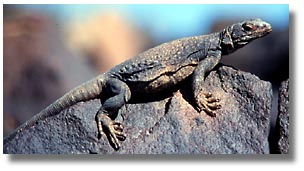Chuckwalla Lizard

Range
Mojave and Sonoran deserts of southeastern
California, southern Nevada and Utah, western Arizona and south to Sonora,
Mexico and the mainland and islands of Baja.
Habitat
Open flats and rocky areas, often near large rocks and boulders.
Description
There is only one species of chuckwalla that inhabits the Southwestern Deserts: the Common Chuckwalla (Sauromalus ater). The San Esteban Island (or Piebald) Chuckwalla (Sauromalus varius), the largest of all the chuckwallas, inhabits only San Esteban Island and Isla Roca Lobos in the Sea of Cortez (Gulf of California). The Piebald Chuckwalla, has a gray-to-black face, with same-colored splotches over its entire body, which is tan to yellow.
There is now and has been a study going on for years at the Arizona Sonora Desert Museum involving San Esteban Island Chuckwallas, where there is a large breeding colony. Among other things, the behavior and reproductive biology of these impressive lizards is being studied there.
There is another Baja Island form which is quite distinctive, Sauromalus hispidus, the Spiny Chuckwalla. This species lives on Isla Angel de la Guarda and several smaller islands near Bahía de Los Angeles. What makes this animal very different is its spiny tail. All other Chuckwallas have a much smoother tail.
Sauromalus ater is the name presently given to all Chuckwallas living in our Southwestern Deserts. All of the former subspecies of S. obesus are now included in the single species, S. ater.
These large, plump lizards have loose folds of skin around the neck and shoulders. They have a thick blunt tail and grow 11 to 18 inches long. These diurnal lizards emerge in the morning and, before seeking food, bask in the sun until its optimum body temperature of 100 - 105 degrees F. is reached.
Strictly herbivorous, it eats fruit, leaves, buds and flowers. When the Chuckwalla senses danger, it scurries between rocks and lodges itself tightly in crevices by inflating itself.In the Common Chuckwalla, depending upon the population, male coloration may include black head, forelegs and upper trunk, and reddish-yellow toward the rear or a showy bright red body. Females are usually a much less showy gray or brown with little pattern. The young, however, are usually quite striking with a dark background color and yellow bands around the body and down onto the tail."
Habitat
Open flats and rocky areas, often near large rocks and boulders.
Description
There is only one species of chuckwalla that inhabits the Southwestern Deserts: the Common Chuckwalla (Sauromalus ater). The San Esteban Island (or Piebald) Chuckwalla (Sauromalus varius), the largest of all the chuckwallas, inhabits only San Esteban Island and Isla Roca Lobos in the Sea of Cortez (Gulf of California). The Piebald Chuckwalla, has a gray-to-black face, with same-colored splotches over its entire body, which is tan to yellow.
There is now and has been a study going on for years at the Arizona Sonora Desert Museum involving San Esteban Island Chuckwallas, where there is a large breeding colony. Among other things, the behavior and reproductive biology of these impressive lizards is being studied there.
There is another Baja Island form which is quite distinctive, Sauromalus hispidus, the Spiny Chuckwalla. This species lives on Isla Angel de la Guarda and several smaller islands near Bahía de Los Angeles. What makes this animal very different is its spiny tail. All other Chuckwallas have a much smoother tail.
Sauromalus ater is the name presently given to all Chuckwallas living in our Southwestern Deserts. All of the former subspecies of S. obesus are now included in the single species, S. ater.
These large, plump lizards have loose folds of skin around the neck and shoulders. They have a thick blunt tail and grow 11 to 18 inches long. These diurnal lizards emerge in the morning and, before seeking food, bask in the sun until its optimum body temperature of 100 - 105 degrees F. is reached.
Strictly herbivorous, it eats fruit, leaves, buds and flowers. When the Chuckwalla senses danger, it scurries between rocks and lodges itself tightly in crevices by inflating itself.In the Common Chuckwalla, depending upon the population, male coloration may include black head, forelegs and upper trunk, and reddish-yellow toward the rear or a showy bright red body. Females are usually a much less showy gray or brown with little pattern. The young, however, are usually quite striking with a dark background color and yellow bands around the body and down onto the tail."